Xin Lv
Advancing Language Model Reasoning through Reinforcement Learning and Inference Scaling
Jan 20, 2025



Abstract:Large language models (LLMs) have demonstrated remarkable capabilities in complex reasoning tasks. However, existing approaches mainly rely on imitation learning and struggle to achieve effective test-time scaling. While reinforcement learning (RL) holds promise for enabling self-exploration and learning from feedback, recent attempts yield only modest improvements in complex reasoning. In this paper, we present T1 to scale RL by encouraging exploration and understand inference scaling. We first initialize the LLM using synthesized chain-of-thought data that integrates trial-and-error and self-verification. To scale RL training, we promote increased sampling diversity through oversampling. We further employ an entropy bonus as an auxiliary loss, alongside a dynamic anchor for regularization to facilitate reward optimization. We demonstrate that T1 with open LLMs as its base exhibits inference scaling behavior and achieves superior performance on challenging math reasoning benchmarks. For example, T1 with Qwen2.5-32B as the base model outperforms the recent Qwen QwQ-32B-Preview model on MATH500, AIME2024, and Omni-math-500. More importantly, we present a simple strategy to examine inference scaling, where increased inference budgets directly lead to T1's better performance without any additional verification. We will open-source the T1 models and the data used to train them at \url{https://github.com/THUDM/T1}.
LongBench v2: Towards Deeper Understanding and Reasoning on Realistic Long-context Multitasks
Dec 19, 2024



Abstract:This paper introduces LongBench v2, a benchmark designed to assess the ability of LLMs to handle long-context problems requiring deep understanding and reasoning across real-world multitasks. LongBench v2 consists of 503 challenging multiple-choice questions, with contexts ranging from 8k to 2M words, across six major task categories: single-document QA, multi-document QA, long in-context learning, long-dialogue history understanding, code repository understanding, and long structured data understanding. To ensure the breadth and the practicality, we collect data from nearly 100 highly educated individuals with diverse professional backgrounds. We employ both automated and manual review processes to maintain high quality and difficulty, resulting in human experts achieving only 53.7% accuracy under a 15-minute time constraint. Our evaluation reveals that the best-performing model, when directly answers the questions, achieves only 50.1% accuracy. In contrast, the o1-preview model, which includes longer reasoning, achieves 57.7%, surpassing the human baseline by 4%. These results highlight the importance of enhanced reasoning ability and scaling inference-time compute to tackle the long-context challenges in LongBench v2. The project is available at https://longbench2.github.io.
LongReward: Improving Long-context Large Language Models with AI Feedback
Oct 28, 2024Abstract:Though significant advancements have been achieved in developing long-context large language models (LLMs), the compromised quality of LLM-synthesized data for supervised fine-tuning (SFT) often affects the long-context performance of SFT models and leads to inherent limitations. In principle, reinforcement learning (RL) with appropriate reward signals can further enhance models' capacities. However, how to obtain reliable rewards in long-context scenarios remains unexplored. To this end, we propose LongReward, a novel method that utilizes an off-the-shelf LLM to provide rewards for long-context model responses from four human-valued dimensions: helpfulness, logicality, faithfulness, and completeness, each with a carefully designed assessment pipeline. By combining LongReward and offline RL algorithm DPO, we are able to effectively improve long-context SFT models. Our experiments indicate that LongReward not only significantly improves models' long-context performance but also enhances their ability to follow short instructions. We also find that long-context DPO with LongReward and conventional short-context DPO can be used together without hurting either one's performance.
Pre-training Distillation for Large Language Models: A Design Space Exploration
Oct 21, 2024



Abstract:Knowledge distillation (KD) aims to transfer knowledge from a large teacher model to a smaller student model. Previous work applying KD in the field of large language models (LLMs) typically focused on the post-training phase, where the student LLM learns directly from instructions and corresponding responses generated by the teacher model. In this paper, we extend KD to the pre-training phase of LLMs, named pre-training distillation (PD). We first conduct a preliminary experiment using GLM-4-9B as the teacher LLM to distill a 1.9B parameter student LLM, validating the effectiveness of PD. Considering the key impact factors of distillation, we systematically explore the design space of pre-training distillation across four aspects: logits processing, loss selection, scaling law, and offline or online logits. We conduct extensive experiments to explore the design space of pre-training distillation and find better configurations and interesting conclusions, such as larger student LLMs generally benefiting more from pre-training distillation, while a larger teacher LLM does not necessarily guarantee better results. We hope our exploration of the design space will inform future practices in pre-training distillation.
Active-Passive Federated Learning for Vertically Partitioned Multi-view Data
Sep 06, 2024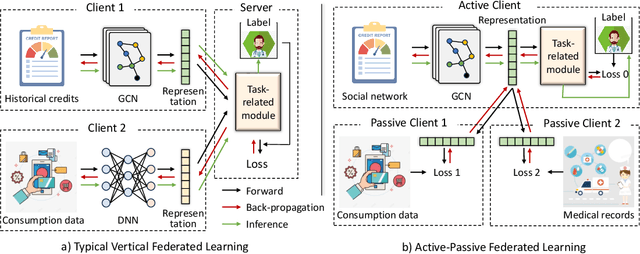


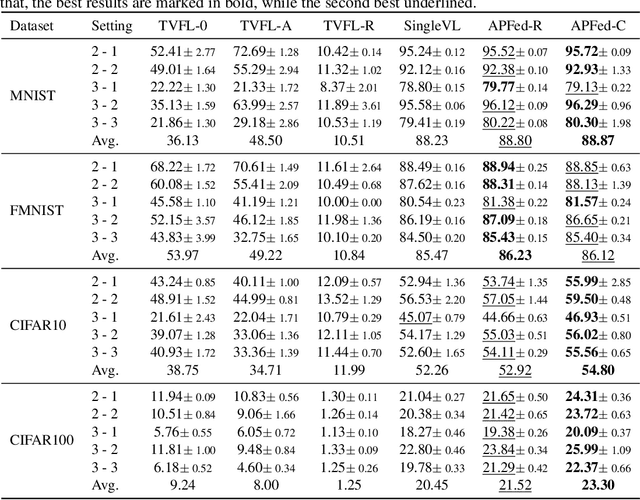
Abstract:Vertical federated learning is a natural and elegant approach to integrate multi-view data vertically partitioned across devices (clients) while preserving their privacies. Apart from the model training, existing methods requires the collaboration of all clients in the model inference. However, the model inference is probably maintained for service in a long time, while the collaboration, especially when the clients belong to different organizations, is unpredictable in real-world scenarios, such as concellation of contract, network unavailablity, etc., resulting in the failure of them. To address this issue, we, at the first attempt, propose a flexible Active-Passive Federated learning (APFed) framework. Specifically, the active client is the initiator of a learning task and responsible to build the complete model, while the passive clients only serve as assistants. Once the model built, the active client can make inference independently. In addition, we instance the APFed framework into two classification methods with employing the reconstruction loss and the contrastive loss on passive clients, respectively. Meanwhile, the two methods are tested in a set of experiments and achieves desired results, validating their effectiveness.
LongCite: Enabling LLMs to Generate Fine-grained Citations in Long-context QA
Sep 04, 2024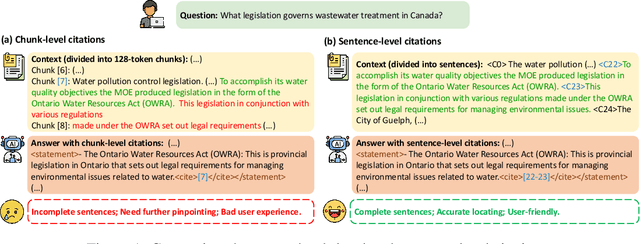


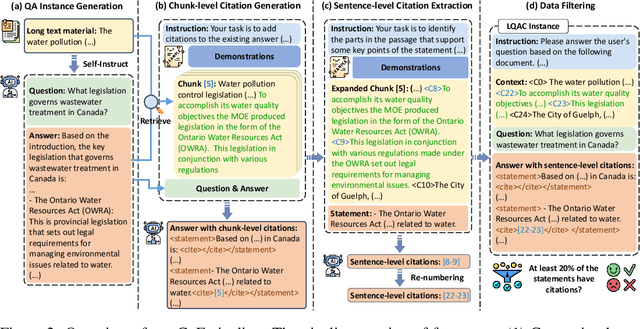
Abstract:Though current long-context large language models (LLMs) have demonstrated impressive capacities in answering user questions based on extensive text, the lack of citations in their responses makes user verification difficult, leading to concerns about their trustworthiness due to their potential hallucinations. In this work, we aim to enable long-context LLMs to generate responses with fine-grained sentence-level citations, improving their faithfulness and verifiability. We first introduce LongBench-Cite, an automated benchmark for assessing current LLMs' performance in Long-Context Question Answering with Citations (LQAC), revealing considerable room for improvement. To this end, we propose CoF (Coarse to Fine), a novel pipeline that utilizes off-the-shelf LLMs to automatically generate long-context QA instances with precise sentence-level citations, and leverage this pipeline to construct LongCite-45k, a large-scale SFT dataset for LQAC. Finally, we train LongCite-8B and LongCite-9B using the LongCite-45k dataset, successfully enabling their generation of accurate responses and fine-grained sentence-level citations in a single output. The evaluation results on LongBench-Cite show that our trained models achieve state-of-the-art citation quality, surpassing advanced proprietary models including GPT-4o.
LongWriter: Unleashing 10,000+ Word Generation from Long Context LLMs
Aug 13, 2024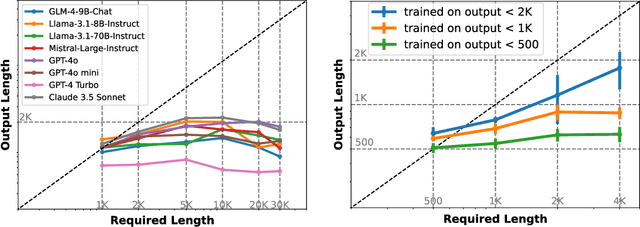


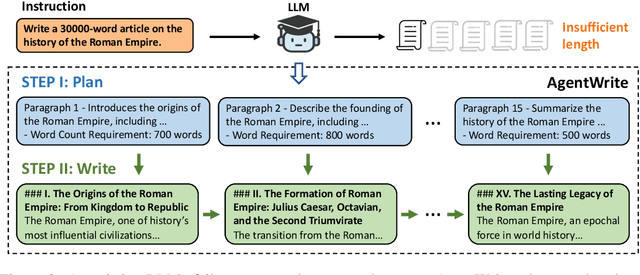
Abstract:Current long context large language models (LLMs) can process inputs up to 100,000 tokens, yet struggle to generate outputs exceeding even a modest length of 2,000 words. Through controlled experiments, we find that the model's effective generation length is inherently bounded by the sample it has seen during supervised fine-tuning (SFT). In other words, their output limitation is due to the scarcity of long-output examples in existing SFT datasets. To address this, we introduce AgentWrite, an agent-based pipeline that decomposes ultra-long generation tasks into subtasks, enabling off-the-shelf LLMs to generate coherent outputs exceeding 20,000 words. Leveraging AgentWrite, we construct LongWriter-6k, a dataset containing 6,000 SFT data with output lengths ranging from 2k to 32k words. By incorporating this dataset into model training, we successfully scale the output length of existing models to over 10,000 words while maintaining output quality. We also develop LongBench-Write, a comprehensive benchmark for evaluating ultra-long generation capabilities. Our 9B parameter model, further improved through DPO, achieves state-of-the-art performance on this benchmark, surpassing even much larger proprietary models. In general, our work demonstrates that existing long context LLM already possesses the potential for a larger output window--all you need is data with extended output during model alignment to unlock this capability. Our code & models are at: https://github.com/THUDM/LongWriter.
SampleAttention: Near-Lossless Acceleration of Long Context LLM Inference with Adaptive Structured Sparse Attention
Jun 28, 2024Abstract:Large language models (LLMs) now support extremely long context windows, but the quadratic complexity of vanilla attention results in significantly long Time-to-First-Token (TTFT) latency. Existing approaches to address this complexity require additional pretraining or finetuning, and often sacrifice model accuracy. In this paper, we first provide both theoretical and empirical foundations for near-lossless sparse attention. We find dynamically capturing head-specific sparse patterns at runtime with low overhead is crucial. To address this, we propose SampleAttention, an adaptive structured and near-lossless sparse attention. Leveraging observed significant sparse patterns, SampleAttention attends to a fixed percentage of adjacent tokens to capture local window patterns, and employs a two-stage query-guided key-value filtering approach, which adaptively select a minimum set of key-values with low overhead, to capture column stripe patterns. Comprehensive evaluations show that SampleAttention can seamlessly replace vanilla attention in off-the-shelf LLMs with nearly no accuracy loss, and reduces TTFT by up to $2.42\times$ compared with FlashAttention.
ChatGLM: A Family of Large Language Models from GLM-130B to GLM-4 All Tools
Jun 18, 2024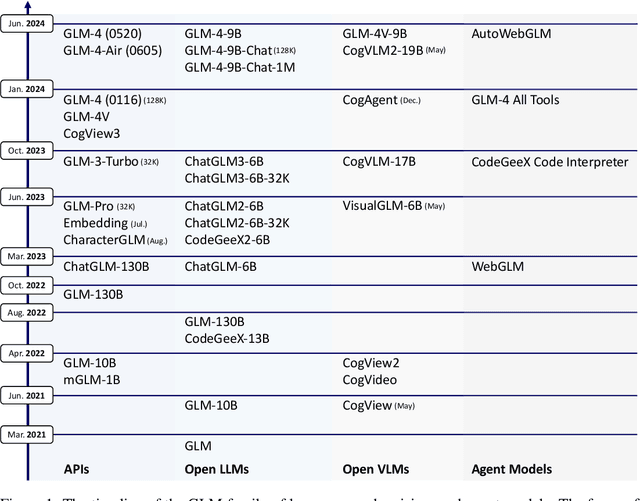
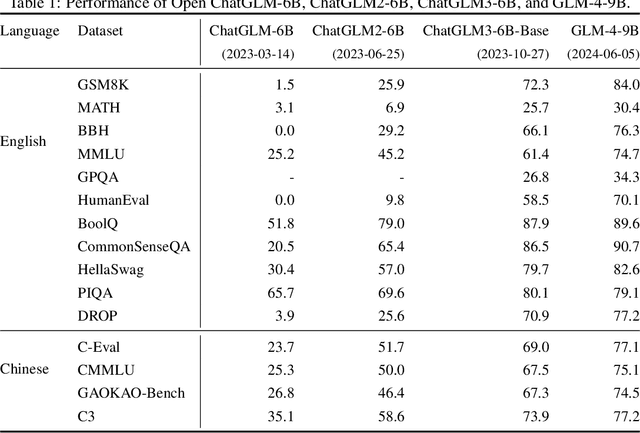
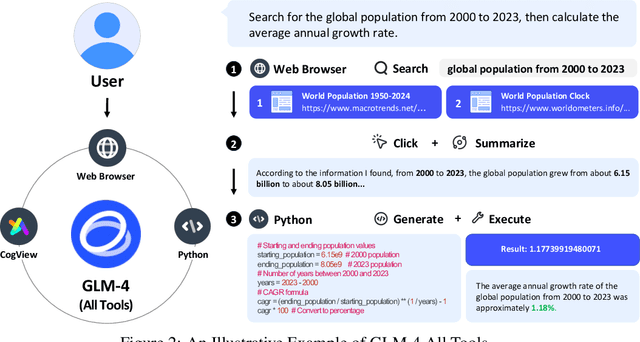
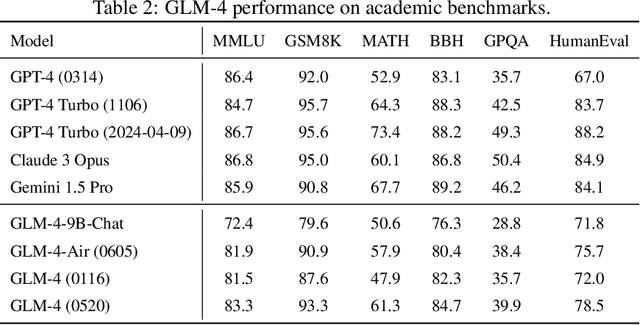
Abstract:We introduce ChatGLM, an evolving family of large language models that we have been developing over time. This report primarily focuses on the GLM-4 language series, which includes GLM-4, GLM-4-Air, and GLM-4-9B. They represent our most capable models that are trained with all the insights and lessons gained from the preceding three generations of ChatGLM. To date, the GLM-4 models are pre-trained on ten trillions of tokens mostly in Chinese and English, along with a small set of corpus from 24 languages, and aligned primarily for Chinese and English usage. The high-quality alignment is achieved via a multi-stage post-training process, which involves supervised fine-tuning and learning from human feedback. Evaluations show that GLM-4 1) closely rivals or outperforms GPT-4 in terms of general metrics such as MMLU, GSM8K, MATH, BBH, GPQA, and HumanEval, 2) gets close to GPT-4-Turbo in instruction following as measured by IFEval, 3) matches GPT-4 Turbo (128K) and Claude 3 for long context tasks, and 4) outperforms GPT-4 in Chinese alignments as measured by AlignBench. The GLM-4 All Tools model is further aligned to understand user intent and autonomously decide when and which tool(s) touse -- including web browser, Python interpreter, text-to-image model, and user-defined functions -- to effectively complete complex tasks. In practical applications, it matches and even surpasses GPT-4 All Tools in tasks like accessing online information via web browsing and solving math problems using Python interpreter. Over the course, we have open-sourced a series of models, including ChatGLM-6B (three generations), GLM-4-9B (128K, 1M), GLM-4V-9B, WebGLM, and CodeGeeX, attracting over 10 million downloads on Hugging face in the year 2023 alone. The open models can be accessed through https://github.com/THUDM and https://huggingface.co/THUDM.
Near-Lossless Acceleration of Long Context LLM Inference with Adaptive Structured Sparse Attention
Jun 17, 2024Abstract:Large language models (LLMs) now support extremely long context windows, but the quadratic complexity of vanilla attention results in significantly long Time-to-First-Token (TTFT) latency. Existing approaches to address this complexity require additional pretraining or finetuning, and often sacrifice model accuracy. In this paper, we first provide both theoretical and empirical foundations for near-lossless sparse attention. We find dynamically capturing head-specific sparse patterns at runtime with low overhead is crucial. To address this, we propose SampleAttention, an adaptive structured and near-lossless sparse attention. Leveraging observed significant sparse patterns, SampleAttention attends to a fixed percentage of adjacent tokens to capture local window patterns, and employs a two-stage query-guided key-value filtering approach, which adaptively select a minimum set of key-values with low overhead, to capture column stripe patterns. Comprehensive evaluations show that SampleAttention can seamlessly replace vanilla attention in off-the-shelf LLMs with nearly no accuracy loss, and reduces TTFT by up to $2.42\times$ compared with FlashAttention.
 Add to Chrome
Add to Chrome Add to Firefox
Add to Firefox Add to Edge
Add to Edge